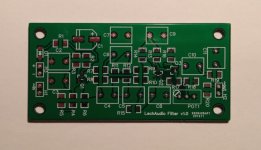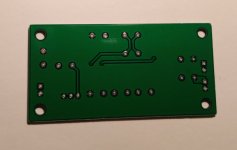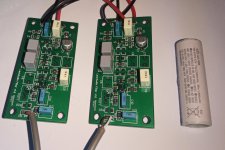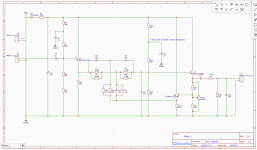Here's my take on some Sallen Key analogue active filters.
Quick summary of the main features:
Each board is intended as a modular 2nd-order filter, configurable as either low-pass, high-pass, or twin-T notch. Multiple boards can be connected in series to increase the filter order or for band-pass.
NPN buffers (BC850C) instead of op-amps.
Minimalist pull-down resistors as current sinks.
Initial testing:
Mostly using a smart-phone or laptop source, a TPA3110 based class D* for bass, and a TAS5704 based class D for treble.
10" STX 27.400.8 woofers in sealed 40L boxes for bass up to ~550Hz
3" Mark Audio CHN-50 full range tweeters in 4L boxes above 550Hz
Dual-gang 10k log pot on the between the source and the input for volume control.
There was a bit of distortion in the high-pass version, which I narrowed down to the 100k load resistors for the buffers, so I changed them to 10k, which fixed that.
There was a 'tolerable' amount of power supply noise, but should be greatly improved with linear regulator and some caps.
Similarly, the dual gang pot that I used to get the prototype up and running seemed to alter the quiescent noise level depending on the gain, suggesting that the headphone outputs like to be loaded down a bit more. And with that in mind, I'm thinking about building a proper pre-amp for it.
*the TPA3110 is set to be upgraded soon.
Quick summary of the main features:
Each board is intended as a modular 2nd-order filter, configurable as either low-pass, high-pass, or twin-T notch. Multiple boards can be connected in series to increase the filter order or for band-pass.
NPN buffers (BC850C) instead of op-amps.
Minimalist pull-down resistors as current sinks.
Initial testing:
Mostly using a smart-phone or laptop source, a TPA3110 based class D* for bass, and a TAS5704 based class D for treble.
10" STX 27.400.8 woofers in sealed 40L boxes for bass up to ~550Hz
3" Mark Audio CHN-50 full range tweeters in 4L boxes above 550Hz
Dual-gang 10k log pot on the between the source and the input for volume control.
There was a bit of distortion in the high-pass version, which I narrowed down to the 100k load resistors for the buffers, so I changed them to 10k, which fixed that.
There was a 'tolerable' amount of power supply noise, but should be greatly improved with linear regulator and some caps.
Similarly, the dual gang pot that I used to get the prototype up and running seemed to alter the quiescent noise level depending on the gain, suggesting that the headphone outputs like to be loaded down a bit more. And with that in mind, I'm thinking about building a proper pre-amp for it.
*the TPA3110 is set to be upgraded soon.
Attachments
Very cool project!
I have something similar in mind in the future as I´d like to exchange the minidsp at one point. I have been eyeing diamond buffers so far as I like the idea of getting by without coupling-Cs as much as possible but that quickly adds up to a whole board full of transistors depending on number of stages and lots of matching.
How did you come up with the circuit?
Did you measure the speakers before and then simulate/adjust the circuit accordingly or is this the attempt and then you measure and adjust?
I have something similar in mind in the future as I´d like to exchange the minidsp at one point. I have been eyeing diamond buffers so far as I like the idea of getting by without coupling-Cs as much as possible but that quickly adds up to a whole board full of transistors depending on number of stages and lots of matching.
How did you come up with the circuit?
Did you measure the speakers before and then simulate/adjust the circuit accordingly or is this the attempt and then you measure and adjust?
Thanks!
I played around with lots of sims in TINA.
Next came some listening to hear if the filters were actually functional, and continuing on from there it's just a process of debugging things in order of least subtle first. Based on experience luckily the filter slopes sounded about right out of the box, and I knew that spending time fine-tuning crossover frequencies and speaker levels would bring less subjective satisfaction than if I improve noise levels first. The TPA3110 amp's rails are common, so I'll checking that, too.
The output capacitor can probably be skipped if it's connected to another stage, and it saves having to use a bench supply or a transformer with a centre tap. Though I might be tempted some day to do a symmetrical version just to settle the whole odd vs even harmonic debate, once and for all. 😀
How did you come up with the circuit?
Did you measure the speakers before and then simulate/adjust the circuit accordingly or is this the attempt and then you measure and adjust?
I played around with lots of sims in TINA.
Next came some listening to hear if the filters were actually functional, and continuing on from there it's just a process of debugging things in order of least subtle first. Based on experience luckily the filter slopes sounded about right out of the box, and I knew that spending time fine-tuning crossover frequencies and speaker levels would bring less subjective satisfaction than if I improve noise levels first. The TPA3110 amp's rails are common, so I'll checking that, too.
The output capacitor can probably be skipped if it's connected to another stage, and it saves having to use a bench supply or a transformer with a centre tap. Though I might be tempted some day to do a symmetrical version just to settle the whole odd vs even harmonic debate, once and for all. 😀



